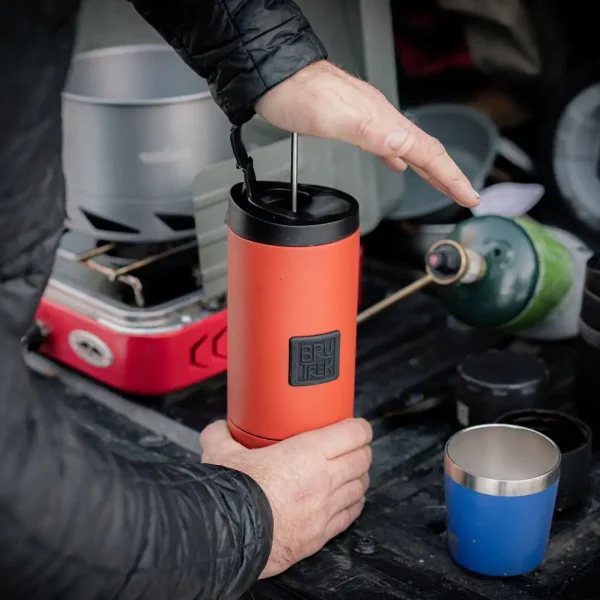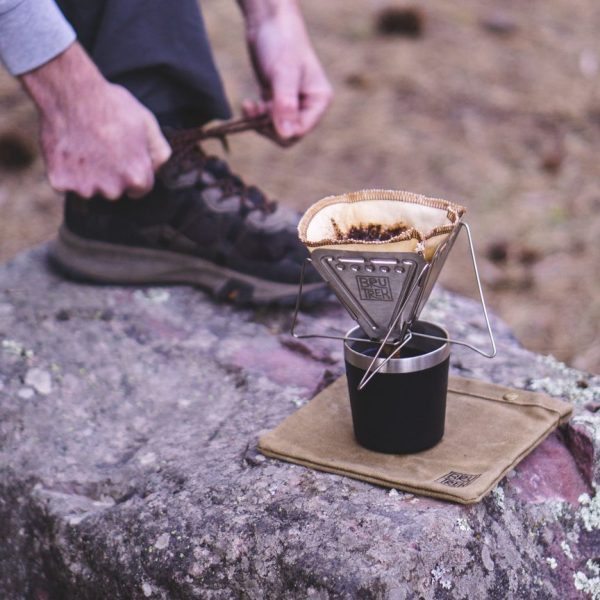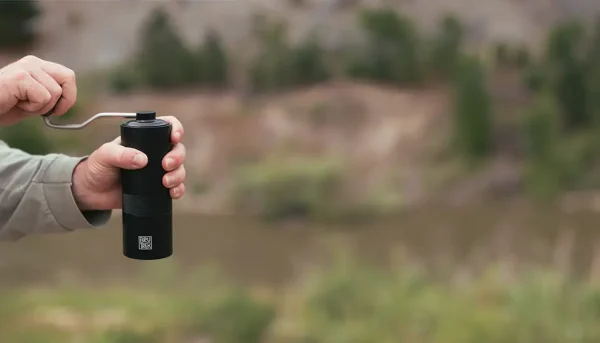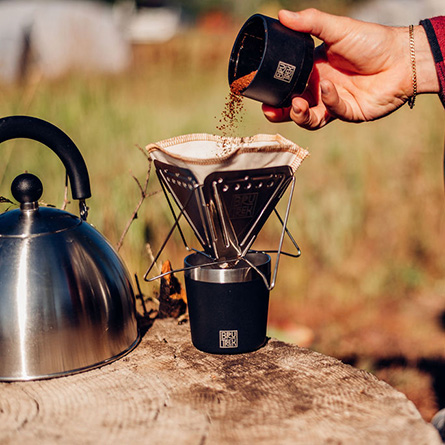French Press vs Pour-Over Coffee: Which is Better?
By Dane Gillespie
When it comes to brewing coffee at home, there are a few different methods that people tend to choose from. Two of the most popular methods are the French press and Pour over. Both of these methods have unique characteristics and flavors, and choosing which one is better depends on your personal preferences.
So, French press vs Pour over – what’s better? Planetary Design takes a closer look at both methods to help you decide which is right.
What is French Press?

A French press, also known as a cafetière or coffee plunger, is a simple but effective way to brew coffee. It consists of a cylindrical glass or stainless steel pot with a plunger and a metal or nylon mesh filter. To use a French press coffee maker, you start by heating water to around 200°F (93°C) and grinding your coffee beans to a coarse consistency. Then, add the ground coffee to the pot and pour in the hot water, stirring gently to ensure all of the coffee is fully saturated.
Next, let the coffee steep for around four minutes before pressing the plunger down to separate the brewed coffee from the grounds. This process traps the grounds at the bottom of the pot, leaving you with a smooth and full-bodied cup of coffee.
Want to learn more about French press coffee? Read our all-inclusive guide on the Best French Press Coffee Makers.
What Is a Pour Over?

A Pour over is a method of manually brewing coffee that involves pouring hot water over ground coffee beans, which are contained in a filter. This allows the water to drip through the grounds and into a carafe or mug below.
There are a few different types of Pour over setups, including the Chemex, Hario V60, Kalita Wave, and now the BruTrek® Collapsible Pour Over. These setups vary slightly in terms of the shape and size of the filter, as well as the shape and size of the carafe or mug. However, the basic principle is the same – hot water is poured over the ground coffee, allowing the water to extract the flavors and oils from the beans as it passes through.
What Is the Taste Difference Between French Press & Drip?
When it comes to taste, both the French press and Pour over have their own unique characteristics. Some people prefer a French press’s smooth, full-bodied flavor, while others prefer a Pour over’s bright and clean flavor.
One of the main reasons why French press coffee tends to taste better than drip coffee is because of the way it is brewed. The metal or nylon mesh filter used in a French press allows some of the finer particles and oils to pass through, resulting in a richer and more flavorful cup of coffee. In contrast, drip coffee makers use a paper filter that traps most of the finer particles and oils, resulting in a cleaner and more balanced flavor.
Why French Press Keeps the Oils in Coffee Better Than Pour Over:
The reasons are a little more complex than just the filter used. The oils in coffee beans are a key factor in the taste and aroma of the final brewed coffee. They contain many of the flavors and aromas that we associate with coffee, including chocolate, nuts, and fruit.
One reason French press coffee may be better at trapping the oils is, as we already mentioned, that it uses a metal or nylon mesh filter rather than a paper filter, as many Pour overs do. Paper filters are designed to remove many of the oils and other small particles from the coffee, which can result in a cleaner-tasting brew. However, this also means that some of the flavors and aromas that are contained in the oils are lost.
On the other hand, the metal or nylon mesh filter in a French press allows more of the oils and small particles to pass through, resulting in a fuller-bodied, richer-tasting coffee. This is because the metal or nylon mesh filter allows more of the oils and other small particles to pass through, resulting in a fuller-bodied, richer-tasting coffee.
Brewing Time & Process:
Another factor to consider is the brewing time. When brewing French press coffee there is typically a longer brew time than drip coffee, which allows for more of the oils to be extracted from the coffee beans. This means that French press coffee may have a more robust, full-bodied flavor compared to drip coffee.
The last factor in French press coffee creating a more rich flavored coffee because of the oils is the brewing process itself. Coffee is brewed by water coming in contact with coffee grounds. With a Pour over coffee, the water is quickly filtered through the grounds into the filter and then into the carafe or mug below, not allowing for as long of a brewing time. With French press coffee, the grounds are in contact with the water the entire 3-5 minute brewing process allowing for the CO2 within the coffee to release and for more of the oils to be passed into the water.
French press coffee may be better at trapping the oils in coffee beans due to its use of a metal or nylon mesh filter and longer brewing time. This can result in a richer, fuller-bodied coffee with more complex flavors and aromas. However, it’s important to note that the final flavor of the coffee will also depend on factors such as the quality and roast of the beans, the water temperature and pH, and the ratio of coffee to water. Experimenting with different brewing methods and adjusting these variables can help you find the perfect cup of coffee for your taste preferences.
Another reason why French press coffee tends to taste better is because of the way it is brewed. When you use a French press, you have complete control over the brewing process, including the water temperature and the steeping time. This allows you to experiment with different brewing parameters to find the perfect flavor profile for your taste buds.
Reasons you may Prefer Pour Over:
With French press coffee, you get complete control over the brewing process, but with Pour over coffee, you get complete control over the rate of coffee extraction and resulting in a more refined control over the brewing process. With a Pour over setup, the coffee maker has control over the rate at which water is added to the coffee grounds, as well as the temperature of the water. This allows for a more precise extraction of flavors from the beans, resulting in a more consistent and balanced cup of coffee.
Another reason why Pour over coffee might taste better is that you prefer to taste more of the “notes” of the coffee beans, which happens when less of the oils and sediments are kept in the brewed coffee like a French press. Pour over is generally made with a paper filter, which removes many of the oils and sediments that can be present in the coffee. These oils and sediments can contribute to a more full-bodied, rich flavor in French press coffee, but they can also make the coffee taste more bitter or muddy. By using a paper filter, Pour over coffee can produce a cleaner, brighter cup of coffee that is free from these unwanted flavors.
So, if your goal is to keep more “notes” within your coffee, Pour over may be the correct brew style for you. Here are some other tips to get the most out of your coffee:
How to Get the Most out of Your Coffee Brew:

Keeping more notes in your coffee during the brewing process can be achieved through a few simple techniques. These techniques will help to extract a wider range of flavors and aromas from the coffee beans, resulting in a richer and more complex cup of coffee:
1. Use the Right Grind Size
The grind size of your coffee beans plays a big role in the flavor and aroma of your coffee. A finer grind will extract more flavor and aroma from the beans, but it can also lead to over-extraction and a bitter taste.
A coarser grind, on the other hand, will extract less flavor and aroma but can result in a cleaner and brighter taste. Experiment with different grind sizes to find the perfect balance for your tastes.
2. Use the Right Water Temperature
Water temperature also plays a role in the extraction of flavor and aroma from coffee beans. Too hot and the coffee can taste burnt and bitter, while too cool and the coffee can taste weak and watery. The ideal brewing temperature for coffee is between 195-205°F (90-96°C).
3. Experiment With the Brew Time
The length of time that the water is in contact with the coffee beans will also affect the flavor and aroma of the coffee. A longer brew time will extract more flavor and aroma, but it can also lead to over-extraction and a bitter taste. A shorter brew time will extract less flavor and aroma but can result in a cleaner and brighter taste. Experiment with different brew times to find the perfect balance for your tastes.
4. Use a High-Quality Coffee Bean
Using a high-quality coffee bean is essential for brewing a great cup of coffee. Look for beans that are fresh and roasted within the past few weeks, as older beans will have lost some of their flavor and aroma. Also, try to find beans that are roasted specifically for the brewing method you will be using (e.g. espresso, drip, etc.).
You may not be able to use your coffee beans within the recommended three-week timeframe. If this is the case, you should look into upgrading your coffee storage with an Airscape® coffee canister.
By using the right grind size, water temperature, brew time, and high-quality coffee beans, you can extract more notes from your coffee during the brewing process, resulting in a richer and more complex cup of coffee.
Other Factors to Consider When Choosing Between French Press & Pour Over:
Over-Extraction
Some people prefer Pour over instead French press coffee because they believe French press coffee produces bitter or sour-tasting coffee. French press coffee is more prone to over-extraction, which can lead to a bitter or sour taste, but this can be minimized by keeping track of the different variables within the brewing process of the French press.
If you ensure that the coffee grounds are ground coarse, the correct temperature (195°-205°) is used, and you press the coffee within the 3-5 minute timeframe, the coffee should not become bitter or sour-tasting.
Over-extraction is still a regular occurrence once the coffee has been pressed in most French presses, like Bodum, even if all the steps are followed perfectly because the grounds continue to interact with the water at the bottom of the French press. This creates a different-tasting cup of coffee at the end of the French press compared to the beginning if not poured out into a different cup right away.
BruTrek® has come up with a solution to this problem. It is called the Bru-Stop™. The Bru-Stop™ halts the brewing process of the French press by introducing a one-way metal plate valve that goes over the top of the French press filter. So, when you press the coffee down, the metal plate flexes like an umbrella allowing the water to filter through while also keeping the coffee grounds firmly below the filter.
Once the grounds are pressed to the bottom, the metal plate relaxes back to its original position, keeps the grounds below the water above, and stops all interaction between them. This is unique in that it doesn’t allow for the over-extraction that happens in other French presses. With the Bru-Stop™, your French press coffee will taste the same from the first sip to the last, and you no longer need to pour the pressed coffee into another cup.
The Bru-Stop™ is just one of the reasons why BruTrek® travel French presses are built for your next adventure. Every BruTrek® travel French press is made to drink out of with the Bru-Stop™ double-wall vacuum-insulated stainless steel body and sip and snap no-spill lid. Your coffee or tea will stay hot for hours and will not over-extract. It will also have a similar drinking experience to your favorite tumbler. BruTrek® has even solved the problem of clean-up with the only removable bottom French press – The OVRLNDR.
Differences in Bloom

Bloom is a phenomenon that occurs when coffee is brewed using the French press method or any other method that involves immersing coffee grounds in water. It is characterized by the formation of a layer of foam or froth on the surface of the coffee.
The reason bloom occurs has to do with the release of gases from the coffee grounds during the brewing process. When coffee beans are roasted, they release gases such as carbon dioxide (CO2). This gas is usually trapped inside the beans and is only released when the beans are ground and exposed to water.
When coffee grounds are placed in water, the CO2 that has been trapped inside the beans begins to escape and rise to the surface, forming a layer of foam. This process is known as degassing. The CO2 that is released during the bloom helps to extract the flavors and aromas from the coffee beans, resulting in a more full-bodied and aromatic cup of coffee.
The bloom can also be influenced by the age of the coffee beans. Freshly roasted beans will have a higher concentration of CO2, which can lead to a more pronounced bloom. On the other hand, beans that have been roasted for a longer period will have less CO2 and may produce a less pronounced bloom. Need help keeping your coffee fresh for longer? Check out these airless coffee canisters.
In addition to CO2, other gases, such as nitrogen and oxygen, may also be released during the bloom. These gases can also contribute to the formation of foam on the surface of the coffee.
The bloom can also be affected by the size of the coffee grounds and the fineness of the grind. Coarser grounds will generally produce a weaker bloom, while finer grounds will produce a stronger bloom. So, with a Pour over, the bloom will last longer and produce a larger foam layer because of the finer grounds. The larger the bloom, the more the gases are released, and also, the more smell is released. So, some people prefer Pour over for this reason – they can control the bloom of their coffee and with it, the smell.
The duration of the bloom can also vary depending on the type of coffee beans and the brewing method being used. In a French press, the bloom typically lasts for about 30 seconds to a minute before the coffee is ready to receive the rest of the water.
Overall, the bloom is an important part of the coffee brewing process and can significantly impact the final product’s taste and aroma. By understanding the factors that contribute to the bloom, you can optimize your brewing process and produce a more delicious cup of coffee.
Brewing Time
Brewing time refers to the length of time that coffee is in contact with water during the brewing process. The brewing time for a Pour over and a French press can vary depending on several factors, including the type of coffee being used, the grind size, and the desired strength of the final brew.
The brewing time for a Pour over is generally shorter than that of a French press, as the water passes through the coffee grounds more quickly. The brewing time for a Pour over can range from as little as 2 minutes to as much as 5 minutes, depending on the factors mentioned above.
The brewing time for a French press is typically longer than that of a Pour over, as the coffee grounds are in contact with the water for longer. The brewing time for a French press can range from as little as 3 minutes to as much as 8 minutes.
So What Coffee Brewing Option Should you Choose?

When comparing a French press vs Pour over, it all comes down to personal preference. If you are looking for a full-bodied cup of coffee, the French press may be best for you. If you are looking for a coffee with more “notes” and a lighter brew, Pour over may be the best option.
What is more important is finding a solution that works for you. Planetary Design has a range of coffee brewing options that coffee lovers can choose from. If you are looking for a durable travel French press that you can bring with you on your next adventure, the BruTrek® OVRLNDR® is a great choice.
If you are looking for a lightweight option for back-packing, the BruTrek® Pour Over may be right for you. How about a refined brew that will look great in your kitchen? Here’s the ethoz® FLASK®.
Still unsure of which brewing option you should choose? Contact Us today so we can help!
